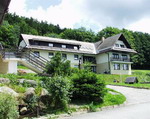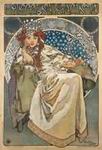Travelling, Accommodation, Holiday, Free time
Bohemian, Moravian, Silesian
|
|
Prague?s Jewish Museum commemorates the 60th anniversary of the end of World War II
|
In 2006 the Jewish Museum in Prague (www.jewishmuseum.cz) will celebrate its centenary. Before that, however, it will also mark the 60th anniversary of the end of World War II. This important anniversary will be commemorated by the Jewish Museum with a ground?breaking exhibition entitled ?Places of suffering of the Czech Jews. Transports to the Baltic Region and Byelorussia in 1941 a 1942?, which will run from 13. 4. until 10. 7. 2005 and illustrate the fate of Czech Jews deported in 1942 in transports from the Nazi Protectorate of Bohemia and Moravia to the east, never documented before. Part of the exhibition will be made up of hundreds of authentic photographs, archive film footage from private collections and excerpts from interviews with those who survived the death camps. The Jewish Museum in Prague possesses one of the most extensive collections of Jewish artefacts in the world. The uniqueness of the collection is not only down to its size, but mainly thanks to the artefacts? origin in just one small historical area, Bohemia and Moravia. The collection provides a complete picture of the life of the Jewish inhabitants of the region.
Prague itself (www.prague-info.cz) is one of the most significant Jewish centres in Central Europe. This year from 13. ? 25. 6. 2005 Prague will host the ?Nine Gates? (www.9bran.cz) Jewish festival. The main theme of the 6th festival will be the history of the Jews in Tsarist and Soviet Russia as well as today?s Russian Federation. A selection of Russian Jewish artists from many areas of artistic life will be performing, as well as representatives of Jewish culture from many other European countries. The festival?s president is the well?known writer Arnošt Lustig.
Prague has experienced growing interest from foreign tourists in Jewish cultural heritage, especially in the last few years. The Jewish sites in the city centre, in particular the Jewish town hall and the six synagogues, are among the most valued sites in Europe. The Old?New Synagogue (www.kehila.cz) is the oldest preserved synagogue north of the Alps, and has been in continual use longer than any other in the world. On the walls of the Pinkas Synagogue visitors can see 80,000 hand written names of Czech and Moravian Jews who died at the hands of the Nazis in World War II. Then there are the Renaissance era Maisel and Vysoká Synagogues, and in the baroque Klaus Synagogue visitors will find the popular exhibition on Jewish traditions and customs. The newest of the six, the Spanish Synagogue, was built in 1868 in the Moorish style and has exquisite interiors decorated with oriental motifs. We should also mention one of the largest and most noteworthy burial sites in the world, the Old Jewish Cemetery, a stone archive of centuries of history and life of the Prague Jewish community. The most important person buried in the cemetery is the great religious scholar and teacher, rabbi Löw, associated with the tale of the Golem. Prague?s most illustrious Jewish German writer Franz Kafka spent almost his entire life in the Jewish quarter and is buried in the New Jewish Cemetery (Želivského metro station).
The stirring fate of the Jews during World War II can also be witnessed at Terezín (www.pamatnik-terezin.cz), roughly 60 km north of Prague. The place itself plus the new permanent exhibition in the Lesser Fortress gives a true reflection of the suffering of tens of thousands of people during the Nazi occupation. The Lesser Fortress served as a Gestapo prison from where prisoners were sent for trial or to other concentration camps. The Terezín ghetto was meant for Jews mostly from the Protectorate, but other nationalities were also held there. Many died of hunger and illness and those who survived were in time sent to death camps. To a limited extent a cultural life was permitted in the Terezín ghetto which served as a smokescreen for what the Nazis really had in store for the Jews. The whole surroundings of the Terezín Fortress as well as the exhibition in the Ghetto Museum illustrates the Nazi vision of a so?called ?final solution?, but also documents the everyday life and cultural activities of those held behind the barbed wire fences. The exhibition in the Magdeburg barracks documents the music, art, literature and theatre produced by the inmates and the main authors who from 1942 ? 1945 in the unimaginably harsh conditions of the concentration camp were able to create many significant works of art, music and literature.
 The importance of Czech Jewish monuments in the world was confirmed in 2003 when the Jewish Quarter Zámostí and the Basilica of St Procopius in Třebíč (www.trebic.cz), a unique example of Christian and Jewish cultures existing side by side, became the 12th site in the Czech Republic to come under UNESCO protection. Zámostí is the first Jewish site outside of Israel to be given UNESCO protection. The remarkably well?preserved Jewish town complete with two synagogues and 123 buildings including a town hall, a rabbinate, a Jewish school, a workhouse, hospital, ritual slaughterhouse, tannery and a cemetery with a ceremonial hall is truly unique. Třebíč?s Jewish cemetery with its 3,000 headstones is one of the largest Jewish cemeteries in the country. The headstones illustrate the centuries? long development of Jewish headstone design, and Hebrew as well as Czech and German inscriptions can be seen on the stones. From 1. ? 6. 8. 2005 Třebíč will come to life for the second popular festival of Jewish culture called Šamajim Třebíč (www.kviztrebic.cz).
The importance of Czech Jewish monuments in the world was confirmed in 2003 when the Jewish Quarter Zámostí and the Basilica of St Procopius in Třebíč (www.trebic.cz), a unique example of Christian and Jewish cultures existing side by side, became the 12th site in the Czech Republic to come under UNESCO protection. Zámostí is the first Jewish site outside of Israel to be given UNESCO protection. The remarkably well?preserved Jewish town complete with two synagogues and 123 buildings including a town hall, a rabbinate, a Jewish school, a workhouse, hospital, ritual slaughterhouse, tannery and a cemetery with a ceremonial hall is truly unique. Třebíč?s Jewish cemetery with its 3,000 headstones is one of the largest Jewish cemeteries in the country. The headstones illustrate the centuries? long development of Jewish headstone design, and Hebrew as well as Czech and German inscriptions can be seen on the stones. From 1. ? 6. 8. 2005 Třebíč will come to life for the second popular festival of Jewish culture called Šamajim Třebíč (www.kviztrebic.cz).
Other noteworthy Jewish monuments in the Czech Republic can be found in Pilsen in West Bohemia and in the Moravian towns of Mikulov, Brno, Holešov and Boskovice. The second largest synagogue in Europe (after the synagogue in Budapest) was built In Pilsen (http://info.plzen-city.cz) at the end of the 19th century. It was constructed in the Moor?Romanesque style, and its impressive interior is not only used for religious purposes, but is open to the public and hosts concerts and exhibitions. A baroque synagogue and 90 Jewish houses have been preserved in Mikulov (www.mikulov.cz), the second largest Jewish centre in the country after Prague. The Jewish cemetery in Mikulov is a particularly valuable place. The most visited part is the so?called "Rabbi?s Hill", where the most eminent Moravian rabbis such as rabbi Menachen Mendl Krochmal and rabbi Šemuel Šmelke Horovitz are buried. Brno (www.brno.cz) can be proud of its functionalist synagogue dating back to 1934?1936 and its Jewish cemetery, one of the largest in Moravia and containing a neo?Renaissance ceremonial hall with Moorish elements dating from 1900. Visitors to Brno can also see one of the most important pieces of modern architecture in the country, the famous Villa Tugendhat, an early work by the architect Mies van der Rohe from 1928-30. The Šachova Synagogue in Holešov (www.holesov.cz, www.olam.cz) is quite unique in Europe as it is one of the few preserved synagogues boasting high baroque decoration with all kinds of floral, fruit and animal motifs. The synagogue dates back to the mid 16th century and houses an exhibition on the history of the Jews and Jewish sites in Moravia. The Jewish ghetto in Boskovice (www.boskovice.cz) is one of the largest in the Czech Republic with 32 protected buildings. The most significant of these is the Great Synagogue with its rich murals from the 17th century and a permanent exhibition on the Jewish town in Boskovice. Boskovice holds an annual festival which aims to preserve and revive the local Jewish quarter. The four?day festival of music (of many genres), theatre, film showings and exhibitions takes place at various sites around the Jewish quarter. The 13th festival will take place this year from 14. ? 17. 7. 2005.
The above mentioned Jewish sights are just a fraction of what the Czech Republic has to offer in this area. The country is peppered with many other Jewish monuments including more than 300 old Jewish cemeteries.
For more information please contact:
Mgr. Helena Kopecká
Czech Tourist Authority ? CzechTourism, PR Dept
tel.: +420 221 580 485
e-mail: kopecka@czechtourism.cz
www.CzechTourism.com
Tuesday 07.05. |
|
 |
25°C |
Wednesday 08.05. |
|
 |
23°C |
Jakému způsobu výběru dovolené dáváte přednost ?
•
Doporučení kamaráda
![]() 26.9% (20154)
26.9% (20154)
•
Sezónní katalog cestovních kanceláří
![]() 18.7% (13992)
18.7% (13992)
•
Nabídka z reklamních letáků
![]() 18.9% (14143)
18.9% (14143)
•
Last minute
![]() 18.1% (13544)
18.1% (13544)
•
Prostřednictvím internetu
![]() 17.4% (13030)
17.4% (13030)
Number of contender 74863
Enter your e-mail for sending news from server E-Czechia.cz.
Copying, publishing and spreading of this server www.e-cesko.cz is recommended and acceptable. We hope that users will enjoy using materials from server www.e-cesko.cz and they will spread this address further. Project E-CESKO.cz came in the existence thanks to the government grant of the Ministry of Regional Development of the Czech Republic.










 An important institution, the Jewish Museum in Prague, will this May commemorate the 60th anniversary of the end of World War II. This summer it will also be two years since the Jewish Quarter in Třebíč was added to the UNESCO list of world heritage sites. These and other Jewish sites host a vibrant cultural life and have much to offer visitors to the Czech Republic.
An important institution, the Jewish Museum in Prague, will this May commemorate the 60th anniversary of the end of World War II. This summer it will also be two years since the Jewish Quarter in Třebíč was added to the UNESCO list of world heritage sites. These and other Jewish sites host a vibrant cultural life and have much to offer visitors to the Czech Republic.